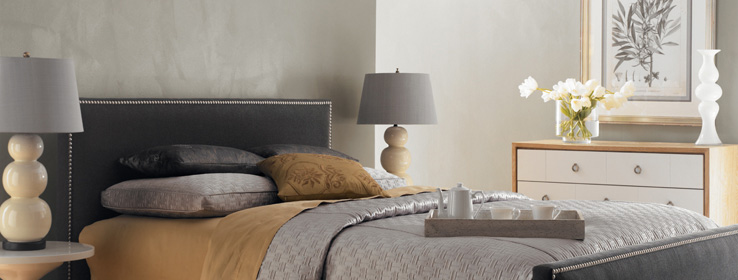The magic of color is that you can use it to make a space appear different.
The magic of color is that you can use it to make things appear different. By creating optical illusions, color has the power to change your visual perception of the shape and size of a room. For example: If you place same-size black and white squares side by side, the black square appears smaller than the white square. The white square lacks sharpness, so the eye automatically perceives it to lack boundaries and appear larger. Conversely, the eye focuses sharply on the black square and sees it as smaller.
Color Hue
The magical power of color extends to living spaces. Soft, lightly tinted, neutral and cool color tones make rooms, furniture and design elements seem larger because they visually recede. In addition, light colors make the best use of natural and artificial light by reflecting it back into the room. And just like walls, floors finished in light colors appear more spacious. However, not everyone can or wants to change or replace their flooring. When this is the case, you can still open things up with a large, light-colored area rug.
Color Saturation
A monochromatic room design – one that uses all the tints and shades of a single color – feels larger than one with varied colors, says Rosemary Sadez Friedmann, a member of the American Society of Interior Designers and president of Rosemary Sadez Friedmann Inc. So does a room with colors of even intensity, such as all bright or all washed colors. Why? Consistency of color reduces the eye's ability to perceive spatial dimensions, resulting in the appearance of spaciousness. In addition, the lack of color contrast yields a more subtle and peaceful energy.
Think of an all-white room with some off-white accents. It evokes a feeling of spaciousness, flow and calm. Then think of a room with a mixture of bright yellow and dark blue. While they can make for a fun, exciting, kinetic space, the contrasting colors make all the room's details pop, leading your eye to stop and start. This effect shrinks your impression of the room's space. Either room can be successful; the point is the color choices can help dictate visual space.
Additional Tips
Here are some additional ways to visually expand or modify space:
Small, square rooms look bigger with two opposite walls of the same color, preferably an intense one. The color creates a feeling of depth, opening up the room. Similarly, a narrow room looks wider if the shorter walls are darker (they advance) and the longer walls are lighter (they recede).
Another solution to small rooms is using gray or blue-gray as background colors. Grays have a "subtractive" influence on adjacent color, making it appear brighter.
Lighting can also change the appearance of a room's dimensions. Lighting can include window light, wall color, reflective surfaces and artwork, as well as lamps and light fixtures. "Anytime you can modulate lighting and have different levels of lighting in one room, you will create more depth," says designer Christine Brun of Christine Brun & Associates.
For Aditionall Information:
The Elements of Design by Joshua David McClurg-Genevese http://www.digital-web.com/articles/elements_of_design/. This Web-based primer is a short, easy-to-read synopsis of color theory and the science behind the tips.
Color in Small Spaces: Palettes and Styles to Fit Your Home by Brenda Grant-Hays and Kim Mikula (McGraw-Hill Professional, 2003). This clever book has tips, techniques and insights to help you plan color schemes that reflect your personality and make small spaces open up.
We Want to Hear From You!
Do you have stories or examples of projects where you used color to solve a design challenge? For example, what techniques did you use for designing rooms with odd angles, low ceilings or no windows? Please submit your ideas with images to feedback@swstir.com. We'll feature them in future issues of STIR® eExtra.










